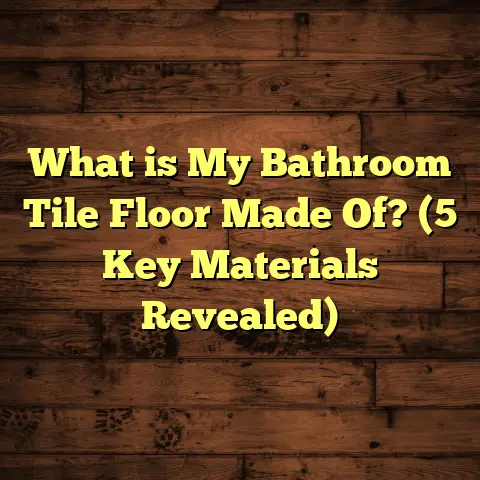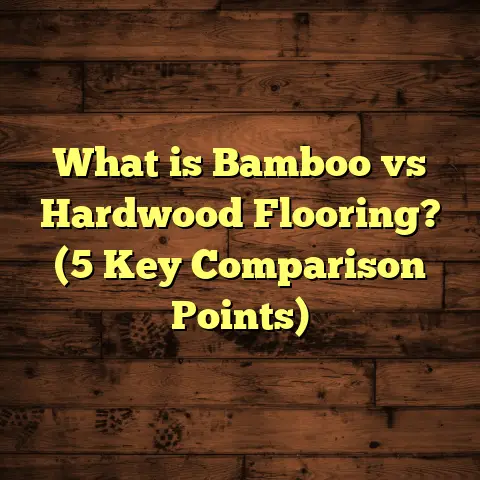What is Calcutta Tile Floor? (5 Benefits You Didn’t Know!)
I’ve seen it countless times—homeowners and renovators staring blankly at flooring samples, overwhelmed by choices that all seem to blur together. You want something beautiful, something that will last, but the options feel endless and confusing. Is it hardwood? Marble? Laminate? What about those fancy tiles that mimic stone? If you’ve ever been stuck in this flooring limbo, wondering which way to turn, I get it completely.
A few years ago, I ran into this exact dilemma while helping a client redo their kitchen and living area. They wanted a marble look but were terrified of marble’s upkeep and cost. That’s when I introduced them to Calcutta tile floors—and it turned out to be a solution that checked every box. If you’re unfamiliar with Calcutta tile floors or what makes them stand out, stick with me. I’m going to walk you through everything: what they are, why they’re becoming so popular, some surprising benefits you probably haven’t heard, plus a few stories from my own projects that highlight their real-world performance.
What is Calcutta Tile Floor?
Calcutta tile floors are porcelain or ceramic tiles designed to replicate the luxurious appearance of Calcutta marble—a type of white marble characterized by striking gray veining. Instead of the real stone, which can be expensive and delicate, these tiles use advanced printing and glazing technologies to capture marble’s classic beauty with the practical advantages of tile.
The name “Calcutta” comes from the original marble quarried near Kolkata (formerly Calcutta), India. This marble is prized worldwide for its elegance and is often used in high-end homes, hotels, and commercial spaces. But because real marble requires sealing, careful cleaning, and can be brittle under heavy use, many people choose porcelain or ceramic tiles that mimic its look without these drawbacks.
Calcutta tile floors typically feature:
- Large format sizes like 24×24 inches or 36×36 inches to minimize grout lines and create a seamless look.
- A polished or matte finish depending on your aesthetic preference.
- High-density porcelain material that’s resistant to moisture, scratches, and stains.
- Printed veining patterns that are random and natural-looking to avoid the repetitive “tile” look.
When I first started recommending Calcutta tile floors, some clients doubted whether tiles could really match marble’s sophistication. But after seeing the finished projects, most are blown away by how realistic and elegant these floors look.
5 Benefits of Calcutta Tile Floors You Didn’t Know About
1. Durability That Handles Everyday Life
One of the first things I always check when suggesting flooring is durability. Will it handle kids running around? Pets? The occasional dropped pan or spilled glass? Real marble looks amazing but has some serious weaknesses here.
Marble is a softer stone with a Mohs hardness rating around 3-4 (on a scale of 1-10), making it susceptible to scratching and chipping. It also absorbs water and acidic substances fairly easily, leading to stains or etching. This means regular sealing and very careful maintenance are necessary if you want to keep it looking pristine.
Calcutta tile floors made from porcelain have a Mohs hardness rating around 7 or more—a big jump in toughness. Porcelain also has an extremely low water absorption rate (usually below 0.5%), which means it doesn’t absorb liquids or moisture like natural stone.
In my experience installing Calcutta tiles in homes with active families (including toddlers and dogs), I’ve seen zero issues with surface damage after months—even years—of daily use. One client told me their dog’s nails haven’t left a single scratch despite frequent running and jumping on the floor.
This durability also extends to commercial settings. I worked on a boutique cafe project where foot traffic was intense—customers coming in and out all day long. The owners chose Calcutta tile floors for their lobby area because they wanted the luxe marble look but needed something that could survive wear-and-tear without constant repairs or replacements.
2. Low Maintenance Without Compromising Style
Marble floors need regular care to maintain their shine and prevent stains. Acidic spills like juice or wine can etch into the stone if not wiped immediately. Plus, polishing marble is a job that requires professional help every few years.
Calcutta tile floors require none of that hassle. They do not need sealing because porcelain is non-porous. Cleaning is as simple as mopping with warm water and mild detergent—no special cleaners needed.
This was a major selling point for an older client of mine who wanted a high-end look but didn’t want the burden of intense floor upkeep. After switching to Calcutta tiles in her bathroom and kitchen, she told me how relieved she felt not having to worry about spills staining her floors.
Statistically speaking, porcelain tiles have been shown to maintain their appearance with minimal maintenance for decades longer than natural stone floors without resealing or refinishing.
3. Cost-Effective Elegance
Marble can be stunning but comes with a big price tag. The material alone can cost between $40 and $100 per square foot depending on quality and origin. Installation is also complicated because marble slabs are heavy and need expert handling to avoid cracking during placement—this pushes labor costs up significantly.
Calcutta tile floors offer that marble appeal at a fraction of the cost. Porcelain tiles usually range from $5 to $15 per square foot for materials alone. Installation tends to be faster and simpler since tiles are lighter and more uniform compared to slabs, reducing labor charges.
When budgeting flooring projects, I often use tools like FloorTally to get accurate cost estimates based on local labor rates and material prices. It’s been a lifesaver for me when planning projects involving different flooring options because it consolidates all data into one place—saving time and reducing surprises during budgeting.
For example, in one recent project where the homeowner wanted marble but had a limited budget, using FloorTally helped us compare multiple options quickly. Calcutta tiles came out as the best value—not only cheaper upfront but also less expensive over time due to lower maintenance costs.
4. Versatile Design Options
One thing that surprised me when working with Calcutta tile floors is just how many design variations are available today. Unlike real marble, which varies naturally but is limited by quarry availability, porcelain tiles can be manufactured with different finishes and sizes:
- Polished Finish: For those who want a mirror-like shine that reflects light beautifully.
- Matte Finish: A softer look that reduces glare—perfect for rooms with lots of natural light.
- Textured Finish: Mimics natural stone textures underfoot for added grip and realism.
- Large Format Tiles: Sizes up to 36×36 inches reduce grout lines dramatically, creating the illusion of one continuous slab.
- Rectangular Planks: For modern layouts that mix the linearity of wood planks with marble patterns.
I remember one client who was torn between polished and matte finishes for their sunroom floor. After testing samples in natural light at different times of day, they chose matte because it cut down on glare but still looked elegant enough for their taste.
This flexibility lets you tailor your floor to your exact style preferences—something I rarely see with natural stone options unless you’re prepared for custom fabrication (which raises costs).
5. Better Eco-Friendliness Compared to Natural Stone
Environmental impact is something more homeowners ask me about now than ever before. Quarrying natural stone damages ecosystems, consumes lots of water and energy, and creates transportation emissions since stones are often shipped worldwide.
Porcelain tiles have a smaller footprint by comparison. They are made from abundant raw materials like clay and sand rather than mined stone blocks. Many manufacturers now incorporate recycled content into their tiles as well.
Plus, porcelain’s durability means less frequent replacement cycles compared to fragile natural stone floors—resulting in less waste over decades.
I once consulted with an environmentally conscious couple who wanted sustainable flooring but didn’t want to sacrifice style. Showing them data on energy consumption for porcelain vs. marble production helped them decide on Calcutta tiles confidently.
Deep Dive Into My Personal Experiences
Now let me share more about some projects where Calcutta tile floors made a real difference:
Case Study: Family Home Kitchen Renovation
This was my own home project last year—my kitchen had old linoleum that looked tired and was hard to clean after cooking messes. I loved the look of marble but knew from experience how tricky it was.
Choosing Calcutta porcelain tiles gave me the best of both worlds: easy cleanup after spaghetti sauce spills plus an elegant finish I could be proud of when guests came over.
I measured the entire kitchen floor (about 200 sq ft) and used FloorTally to estimate costs quickly. Including materials, installation labor, waste factor (about 10%), and delivery fees, I had a clear budget plan from day one.
After installation, I noticed how much cooler the kitchen felt underfoot compared to hardwood—an unexpected bonus in our hot climate.
Commercial Project: Boutique Hotel Lobby
A boutique hotel owner wanted an upscale vibe without breaking renovation budgets or extending timelines too much.
We selected large-format Calcutta tiles with polished finishes for the lobby floor because:
- The tiles were easier/faster to install than marble slabs.
- They resisted high foot traffic without visible wear.
- Maintenance staff reported fewer cleaning challenges compared to previous stone floors.
Data from their property manager showed reduced maintenance costs by nearly 50% in the first six months after installation—a huge win for ongoing operations.
How Calcutta Tiles Compare With Other Popular Flooring Choices
If you’re still weighing options, here’s a look at how Calcutta tile flooring stacks up against other common materials:
| Flooring Type | Durability | Maintenance | Cost Range (Materials) | Aesthetic Appeal | Longevity |
|---|---|---|---|---|---|
| Calcutta Tile (Porcelain) | Very high; scratch & moisture resistant | Low; easy cleaning, no sealing | $5 – $15 per sq ft | Elegant marble mimicry | 20+ years |
| Natural Calcutta Marble | Moderate; prone to scratches & stains | High; requires sealing & polishing | $40 – $100 per sq ft | Genuine luxury & uniqueness | 30+ years |
| Hardwood Flooring | Moderate; vulnerable to dents & moisture | Medium; refinishing needed | $8 – $15 per sq ft | Warmth & classic appeal | 20+ years |
| Luxury Vinyl Planks (LVP) | Moderate; scratch resistant but can dent | Low; easy cleaning | $2 – $7 per sq ft | Wide variety of looks | 10-20 years |
| Laminate Flooring | Moderate; can scratch & warp | Low; easy cleaning | $1 – $5 per sq ft | Many styles including wood looks | 10-15 years |
From my standpoint, if you want sophistication without the fragility or cost of real stone—and better durability than wood or vinyl—Calcutta tile floors hit the sweet spot perfectly.
What About Installation?
I can’t stress enough how much smoother installation goes with porcelain Calcutta tiles compared to natural marble slabs.
Because porcelain tiles are lighter, more uniform in thickness, and less brittle during handling, installers can work faster with fewer risks of breakage. This usually means lower labor costs and shorter project timelines.
For homeowners considering DIY installation, large format tiles may present challenges due to weight and required precision leveling—but smaller formats can be manageable with some experience.
Using FloorTally helped me plan installation needs precisely by accounting for:
- Exact square footage
- Waste allowance (usually 10-15%)
- Labor rates based on local averages
- Material delivery fees
This level of detail helps avoid surprises mid-project—something I always recommend whether you’re DIY’ing or hiring pros.
What About Grout?
Grout color selection plays a huge role in final appearance with large-format Calcutta tiles since grout lines can either blend seamlessly or create contrast.
For a continuous marble slab effect, I suggest choosing grout colors close to the base tile color (usually white or light gray).
In several projects I’ve done personally, matching grout helped maintain the illusion of one solid slab rather than tiled pieces—which really elevates the space visually.
How Do These Tiles Perform Under Different Conditions?
I’ve installed Calcutta tile floors in various climates—from humid coastal homes to dry mountain cabins—and they have performed consistently well.
Porcelain’s low moisture absorption means no swelling or warping even in bathrooms or basements prone to dampness.
In colder climates where freeze-thaw cycles are common outdoors, porcelain tiles designed for exterior use can withstand these conditions without cracking—a big advantage over natural stone in similar settings.
Can You Use Calcutta Tile Floors Outdoors?
Yes! There are specific porcelain versions rated for outdoor use with textured finishes for slip resistance. This opens up possibilities like patios or entryways with the elegant look of marble but built for weather exposure.
Personal Tips For Choosing Your Calcutta Tile Floor
Here are some things I’ve learned over time:
- Sample First: Always get physical tile samples before committing—lighting affects how veining appears.
- Think About Finishes: Polished is glamorous but shows scratches more easily; matte is forgiving yet upscale.
- Plan Your Layout: Large format tiles require precise installation; factor in this cost.
- Use Professional Installation if Possible: DIY can save money but mistakes on large tiles can be costly.
- Consider Grout Carefully: It can either make or break your design flow.
- Budget Realistically: Include waste factor; I generally budget an extra 10% material for cutting mistakes or future repairs.
- Use Tools Like FloorTally: For estimating total costs quickly based on your region—it’s helped me avoid budgeting errors multiple times.
Final Thoughts
If you want my honest opinion after years in flooring work: Calcutta tile floors offer an unbeatable combination of elegance, durability, affordability, and ease-of-care compared to real marble or other flooring types.
I hope this deep dive helps you feel more confident about what they are and why they might be perfect for your home or project.
What about you? Have you seen Calcutta tiles around your neighborhood? Are you thinking of trying them out? If you want help calculating costs or planning layouts based on your space specifics, just ask—I’m always happy to share what I know!
After all, picking the right floor isn’t just about looks—it’s about making your space live better for years ahead.





